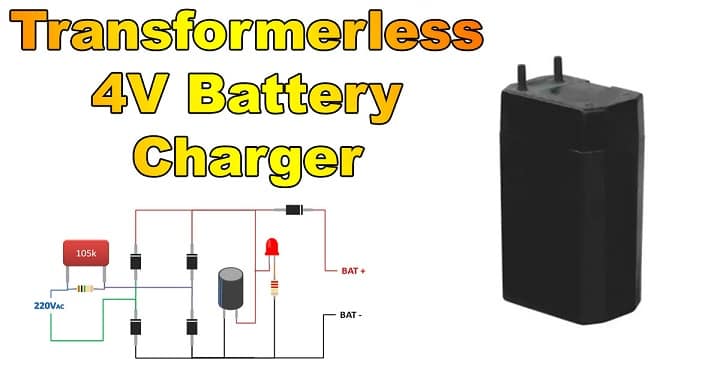Transformerless 4V Battery Charger | 230V AC to 4V DC
[Sekhohub.online]
A transformerless power supply is a compact and inexpensive way to charge small batteries or power low-current electronics directly from AC mains without using a bulky transformer. This guide shows how to build a simple 4V battery charger using.
Materials for the Project
| Component | Value/Part | Quantity |
|---|---|---|
| Non-Polar Capacitor | 1 µF / 400 V | 1 |
| Electrolytic Capacitor | 100 µF / 25 V | 1 |
| Diode | 1N4007 | 4 |
| Resistor (Protection) | 1K Ohm, 1/4W | 1 |
| Resistor (Bleeder) | 1M Ohm, 1/4W | 1 |
| LED (Indicator) | Red/Green | 1 |
| Output Battery | 3.7V–4.2V Li-ion | 1 |
Download Circuit Diagram
Circuit Diagram
Working Principle:
A 1 µF/400 V non-polar capacitor drops the AC voltage without heating.
A 1KΩ resistor limits inrush current at power-on.
A 1MΩ resistor discharges the 1µF capacitor when unplugged (safety bleeder).
1N4007 diodes form a full-wave bridge rectifier to convert AC to DC.
A 100 µF capacitor smooths out the rectified voltage for DC output.
LED indicates charging status or power presence.
⚠️ Safety Tips:
Dangerous High Voltage—This circuit is directly connected to 220V AC. Take extreme caution.
No Isolation—Do not touch any part of the circuit when connected to mains.
Fuse Recommended – Add a 0.5A fuse in series for protection.
Use for Small Loads Only—This setup is good for charging a 4V 200–500 mAh battery only.
Enclose It Properly—Always enclose it in an insulated case.
✅ Output:
Voltage Output: 4.5V–5V DC approx. (drops under load)
Current Output: Around 20 mA–60 mA (depends on capacitor used)
Perfect for charging a small 3.7V Li-ion or 4V lead-acid battery slowly.
Final Thoughts:
This transformerless battery charger is a low-cost and simple solution for small electronics and DIY projects. However, never use this for high-current batteries or USB-powered devices. For educational and low-power tasks, it’s a neat and effective design.


